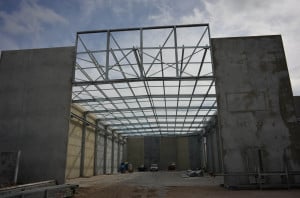Stay up to date
Should You Choose A Concrete, Timber Or Steel Structure?
25 August 2016

Concrete, timber and steel are three of the most common building materials used today. The material you should choose for your structure depends on many factors, such as the type of building, your budget, and the capabilities of your worksite. Concrete, timber and steel each comes with their own advantages and challenges, so which one should you choose?
Concrete
Concrete has been used since ancient times, and today it’s often chosen for its durability, versatility, thermal mass, and low maintenance. For high-rise buildings or long-span bridges, structural concrete provides maximum strength, durability, and the ability to withstand a high level of tensile stress. Concrete is environmentally friendly because it is made from readily available materials – sand and limestone – and it’s also fire and weather resistant. Choosing a concrete structure also provides a wealth of aesthetic possibilities. Concrete can be easily incorporated with other materials to create colours or patterns, and it can be moulded into any number of shapes, because it starts in liquid form. Compared to steel, concrete requires less skill to erect. However, because of the many steps involved in erecting reinforced concrete, the final strength can sometimes be affected if there has been poor workmanship. Another risk with concrete is that shrinkage can cause cracks or loss of strength.
Timber
Timber is cost effective, naturally durable and has a high structural efficiency as carried load per unit. If it’s sourced from sustainably managed forests, it can be a more environmentally friendly choice than steel or other building materials. Timber is ideal for use internally as it maintains a pleasant level of humidity inside a dwelling, and it absorbs sound – preventing echo and noise inside. The natural beauty and warmth of wood creates an aesthetically pleasing atmosphere, as each tree has its own colours, smells and patterns, depending on how it was sliced. Timber is lightweight, easy to work with, and adaptable to offsite manufacturing, so it is often used in low-rise residential structures. However, timber can deteriorate over time due to decay, mould, bacteria, insects, weather or fire. This means a timber structure may require more maintenance than concrete or steel.
Steel
Steel has a high strength to weight ratio, making it a better structural material for high-rise buildings, long-span bridges, or buildings on soft ground. Steel is often used in major construction to speed up development, reduce onsite risks, and minimise waste. Computer modeling can be used to ensure components are manufactured correctly the first time, minimising rework. Buildings with steel structures are often lighter and have smaller foundations because steel is structurally efficient. Steel structures can be erected quickly and with fewer workers needed onsite, reducing labour costs. Compared to concrete, erecting a steel structure creates less noise and dust on a worksite and surrounding areas. Steel is fire resistant, termite free, and a large portion of steel can be recycled. However, there can be disadvantages to choosing steel: it can be more expensive, could be susceptible to corrosion and may need to be repainted regularly. Steel also conducts and transmits heat, so steel structures needs to be fireproofed correctly.
WA Steel is a locally owned and operated specialist fabricator offering steel fabrication, metal fabrication, and sheet metal fabrication services in Perth. With almost 30 years of industry experience, highly specialised solutions, and the latest technology, WA Steel is the ideal choice for your steel structure project. To find out more, call WA Steel on 08 9377 3778 or visit www.wasteel.com.au
Share